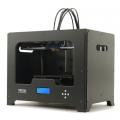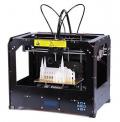Results 21 to 30 of 52
-
01-10-2016, 06:58 AM #21
Aardvark,
Most of my prints are also functional parts, so in most cases surface perfection is not needed. So what PLA based material, (you have or are using) that is superior to ABS do you recommend? Please be specific as I want to purchase and try.
I'm open to trying replacement materials for ABS, but since I have never had any problems printing with ABS that were not my own mistakes, I just haven't had the need to try the PLA alternatives.
-
01-10-2016, 07:37 AM #22
Note that all industrial/pro printers have enclosed chambers and by doing so you can tap into the properties of ABS if required.
Again, a simple thing as enclosing and heating the print chamber will sort out all ABS issues. Does this make ABS better? These two very different with very different properties. You should use/do whatever is required for the job.
-
01-11-2016, 09:51 AM #23
You know, thinking about it I started with abs. Took a while to get a decent print - think it was a round a week before I had the first 100% succesful print.
And while it was a PITA at the time, it definitely taught me a helluva lot mkore about my printer and 3d printing than I'd have learned if I'd started with pla and everything has just worked from day one :-)
So I'll give abs another use - great for teaching you - albeit frustrating at the time - how to properly use your printer :-)
@servicexp
I prefer to use reprappertech pla. Never had any issues with it and parts I've made that broke with abs don't break with it.
Also anything by polymaker is excellent stuff.
Try to print as hot as you can - as this will give you much better layer bonding. I pretty much now default to 210 for most pla. Slightly lower for black and try to avoid printing in white as much as possible.
I find the colourant in white makes it brittle - had the same with abs in that it cracked a lot more than other colours.
Best filament I've used is reprappertech 'wood'. It's a semi transparent brown/bronzy colour. And just a fabulous filament all round. Unless I need a specific colour I'll use that for pretty much everything.
Flexible wise - polymaker polyflex is hands down my favourite. Not as stretchy as ninjaflex - but prints just like normal pla - just a wee bit hotter.
Fantastic stuff. And a lot cheaper than ninjaflex as well :-)
My biggest issue with abs was the shrinkage. I like my cad models to print the size I program them to be - rather than smaller. :-)
And not having to go near acetone is also a big bonus and the lack of burning plastic smell in the workshop.
A lot of difference can be made in the orientation of a print. I made some little square 'u' shaped clips. Initialy printed them with the bas down and the arms pointing up.
Pla ones broke very easily where they jolined the base - not alayer bonding issue - that was simply the weakest mechanical point.
Ended up using pet at the same orientation and they worked much better.
Then had a brainwave and printed them laying down, this completely removed the mechanical weakness as the entire outline was one piece.
The pla ones are now more flexible, stiffer and stronger than the pet ones. And they look better as well and print quicker :-)
So it's not only what plastic you use - but how you use it as well and how you design and print your designs.
-
01-12-2016, 02:04 AM #24
Hope to be able to try out some these others brands soon. All we get here is Makerbot, eSun and Wanhoa filaments.
-
01-12-2016, 08:07 AM #25
Here's a good video about difference in ABS and PLA:
http://www.bing.com/videos/search?q=...45AC56262E4F06
-
01-12-2016, 08:34 AM #26Technician

- Join Date
- Jun 2014
- Location
- 3D Printer Tellus
- Posts
- 83
The easiest way to see which one is the best is to buy one of each to test it out. After print, try break it, the result will be direct!
-
01-12-2016, 08:42 AM #27
Thanks for the information, I should have asked were are you located? I don't see any US option for reprappertech? I see some on Amazon for Polymaker PolyMax and PolyPlus along with some flex versions. So I may start there, maybe with the PolyMax... I've been learning about the effects of print orientation, and model design have on the stability of the part. It's been quite remarkable to see just how important that one change (print orientation) can be.
-
01-12-2016, 03:10 PM #28Engineer-in-Training

- Join Date
- Jan 2016
- Posts
- 326
I can't decide which filament is best. Trying to read reviews of filaments in Amazon confused me. For example, most people say that "Brand A" is good but some people say that "Brand A" is junk.
-
01-12-2016, 03:10 PM #29
Yes it is amazing how changing the smallest of parameters can have a huge affect on the print.
-
01-13-2016, 10:45 AM #30
@ jeff
lol yeah. I got two rolls of esun pla with my klic-n-print machine. Hands down the worst filaments I've ever tried.
And yet esun has a good name - so who knows.
What you need to bear in mind is that environmental conditions also play a fairly significant part. My workshop is pretty much always around 45-55% humidity. Temps vary between 14c in winter (today for example) and a max of 27 in the summer.
I find that this seems to be ideal conditions for most pla and leaving it out of airtight packaging doesn't seem to effect it at all either.
With white filament The bit of filament in the tube can become brittle. But I reckon that's more to do with the white colourant than the pla itself.
So everyone's working environment is different - that's one set of variables
How you have your machine setup can be a lot different. The slicer you use can be different, the way you design will be different, and the speed, infill and shellls/layers you use will also most likely be different.
If you mix all those variables together - it's no wonder that the same filament can perform differently for different people.







 Reply With Quote
Reply With Quote









Print not sticking to base plate?
Yesterday, 01:26 PM in General 3D Printing Discussion